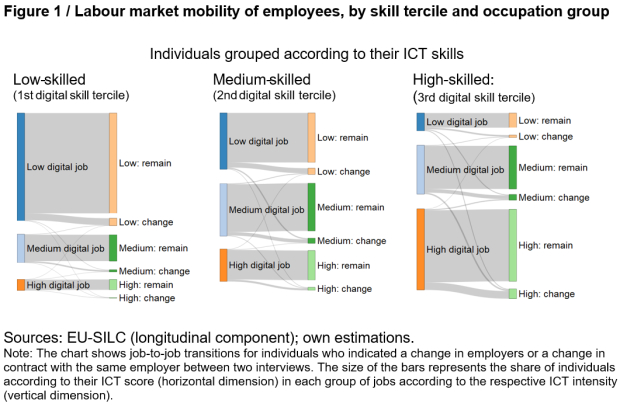Breaking through the digital ceiling: ICT skills and labour market opportunities
04 February 2021
Jobs which require strong ICT-skills are more secure. Absence of ICT-skills limit labour market opportunities.
by David Pichler and Robert Stehrer
photo: iStock.com/Ngampol Thongsay
- This paper provides econometric evidence that ICT skills or the lack thereof affect individuals’ labour market opportunities.
- Higher ICT skills are associated with a higher probability of changing jobs in favour of medium or high digital employment.
- ICT skills increase the probability of unemployed individuals finding medium or high digital jobs, which are on average better paid and more often offer permanent contracts.
- Therefore, lack of ICT skills clearly limits labour market opportunities and can thus function as a ceiling for finding well-paid jobs.
- Moreover, an increase in the ICT score for individuals who are employed in low digital occupations is associated with a lower risk of facing periods of unemployment that last longer than six months. This, however, is only true for individuals who exceed a certain minimum level of digital skills.
Where the labour market is concerned, few policy reports refrain from highlighting the importance of digital upskilling of the labour force. In a recently published paper, we analyse the impact of ICT-skills on three individuals’ labour market mobility patterns: (i) job-to-job, (ii) employment- to-unemployment and (iii) unemployment-to-employment transitions. This research is based on a novel combination of data from the Organisation for Economic Co-operation and Development (OECD)’s Programme for the International Assessment of Adult Competencies (PIAAC) and longitudinal European Union Statistics on Income and Living Conditions (EU-SILC) data. This allows us to study individuals’ labour market outcomes over the period 2011-2017 in nine EU Member States and the UK. First, from the PIAAC data we derive an indicator of occupational ICT intensity for each 2-digit International Standard Classification of Occupations (ISCO) occupation based on the PIAAC’s “skill use at work” indicators. This allows us to split jobs into low, medium and high digitally intensive jobs. Second, applying econometric methods based on the PIAAC data allows us to predict ICT scores for persons with the same characteristics as in the EU-SILC data. An individual is considered to have low digital skills if she is positioned in the lowest tercile of an ICT test score distribution while individuals with high digital skills are in the top 33% of the ICT test scores
Selected descriptive evidence of mobility by ICT intensity of jobs and ICT skills
Figure 1 shows the job-mobility patterns for individuals with low, medium and high digital skills for each of the three groups of jobs (low, medium, and high digitally intensive), respectively. First, this clearly indicates that people with lower ICT-skills tend to be more represented in lower ICT-intensive jobs, and analogously for persons with higher ICT skills. However, the focus of the study is on mobility patterns between ICT jobs. Overall, around 13% of individuals in our sample changed jobs or contracts at least once between two interviews (job-to-job transition). The data reveal that individuals with higher digital skills change jobs more often than those with fewer digital competences. While 14.5% of all (digitally) high-skilled workers change jobs within one year, only 10.3% of all low-skilled workers do so. Both low- and medium-skilled employees change mainly to low digital occupations, although half of the job changes of medium-skilled employees are to medium or high digital occupations. Furthermore, half of the job-to-job transitions of employees in the third skill tercile target high digital occupations, and another third transit to medium-skilled jobs.
Concerning unemployment experience, the data indicate that individuals in the lowest skill tercile are twice as likely to be unemployed as individuals in the top tercile. There is also a significant difference with respect to transition from employment to unemployment: While only 2.2% of individuals in the top tercile were unemployed in period t given employment in period t−1, 3.8% of the bottom tercile transited to unemployment. Furthermore, individuals in the top tercile wee almost twice as likely to exit unemployment as those in the bottom tercile.
Regression results
Job-to-job transitions
These descriptive results are broadly confirmed by a detailed econometric analysis. Our results indicate that individuals with strong ICT skills have better opportunities and are therefore not only more likely to change jobs more frequently but are also less likely to face unemployment. Furthermore, ICT skills support unemployment exit towards medium and high digital occupations. A certain minimum level of ICT skills also supports unemployment exit towards low digital occupations but seems to make employment in such occupations less likely once a certain skill-threshold is crossed.
Furthermore, the results suggest that individuals who possess strong ICT skills tend to have greater opportunities in the labour market. ICT skills increase the probability of progressing towards a new job, and especially towards jobs which are characterised by ICT-intensive tasks. These jobs tend to be better paid and are more likely to offer permanent contracts.
Transitions to and from unemployment
When analysing the relationship between ICT skills and unemployment, we find that individuals with high ICT skills are less likely to be unemployed and tend to exit unemployment more quickly. Moreover, an increase in ICT skills is associated with a reduced risk of unemployment for individuals who are employed in low digital occupations. This relationship, however, holds only for individuals who exceed a certain minimum level of digital skills. The results suggest that individuals at the very bottom of the ICT skills level are the most affected by the shift in demand towards digital skills. Still, there are many jobs which do not require strong ICT skills.

